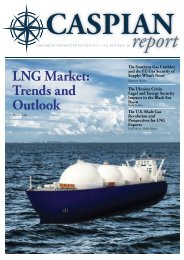Caspian Report - Issue: 07 - Spring 2014
Create successful ePaper yourself
Turn your PDF publications into a flip-book with our unique Google optimized e-Paper software.
After a decade of volatile prices, the past<br />
three years saw an unusual period of<br />
stability in the oil market, with a barrel of<br />
crude oil averaging $110 each year.<br />
After a decade of volatile prices, the<br />
past three years saw an unusual<br />
period of stability in the oil market,<br />
with a barrel of crude oil averaging<br />
$110 each year. However, forecasts<br />
for <strong>2014</strong> predict a decline to an average<br />
of $105, on the basis of expanding<br />
supply and a weaker-thanexpected<br />
demand. A combination of<br />
geopolitical events in Syria, Libya<br />
and Nigeria have prevented oversupply<br />
despite the expanding entry of US<br />
shale oil into the market. The price<br />
has remained high thus far, but how<br />
long can prices stay above $100<br />
This coming price drop arrives at a<br />
time when the world’s largest consumer<br />
is nearing its long-held goal of<br />
energy self-sufficiency. The United<br />
States embarked on this quest in the<br />
aftermath of the 1973 oil crisis, and<br />
in recent years has seen the country<br />
develop a comprehensive nuclear<br />
program, develop biofuels and<br />
seek oil from ever-more-expensive<br />
sources: the tar sands of Canada, the<br />
depths of the Gulf of Mexico and even<br />
the wilds of Alaska. Further afield, it<br />
drew on oil from Brazil’s deep-water<br />
wells and West Africa’s low-sulphur<br />
oil deposits, all of which contributes<br />
to a reduced dependency on oil from<br />
the Middle East.<br />
More recently, the development of<br />
unconventional sources of oil and<br />
gas back in the United States has led<br />
to a revolution in energy flows and<br />
policies, as the country stands on<br />
the verge of becoming a gas exporter.<br />
The rapid development of shale oil<br />
and gas fields has seemed miraculous<br />
at times, but like many of the<br />
conventional sources the US relies<br />
upon the production is more expensive<br />
(costing $60-80 per barrel) and<br />
more risky, as output and depletion<br />
rates seem less predictable than conventional<br />
sources. As a result US domestic<br />
and regional supply is quite<br />
vulnerable to price fluctuations, as<br />
witnessed when work at the tar<br />
sands of Canada came to a standstill<br />
in 2008 following a price drop.<br />
Analysts have claimed that the age of<br />
“easy oil” is over, and we are entering<br />
a period of expensive extraction and<br />
capital-intensive processing. With<br />
the shale oil and gas sector currently<br />
requiring $1.5 in capital investment<br />
1<strong>07</strong><br />
CASPIAN REPORT, SPRING <strong>2014</strong>










